What I miss about the place are the sounds. Hisses. Sputters. Splutters. Burps. I miss the place and I think of onomatopoetic words: Fissure. Muck. Splatter. Whisper. Burble. Splat. Slurp. Sludge. Pop. Hiss. Surge.
I remember standing in a pastoral landscape. I’d shrunk into a painting in one of the National Gallery of Art’s more boring galleries. I’d fallen into a Remington, a Russell, a Catlin, a Bierstadt, a Moran masterpiece. Or I’d stepped into one of God’s masterpieces, and those men (and I, with words I’m writing now) were all attempting a copy of the original. Or maybe I’d conjured to full-scale the cover of a Louis L’Amour paperback I devoured as a teenager. What magic brought me to a buffalo-dotted plain, mountains in the distance, sunlight spearing the tips of a ridge of lodgepole pines, grasses tickling my kneecaps as I waited for—surely any minute now—a feathered indian to ride by, bareback on a warrior of a painted pony? The magic was real, I assure myself now as I sit at home no longer framed in a masterpiece. I saw all of this, I affirm, minus the indigenous people and horses.
I think of the place, and I remember the signs that marked trailheads, signs dogged in determination to warn passersby of dangers. “Do not mess with this place. Do not even think about it.” The message either took a constant beating from sun, steam, rain, snow, and wind, or went ignored by the human eyes looking ahead to the sights: bubbling cauldrons, steaming mud, and pools of death.
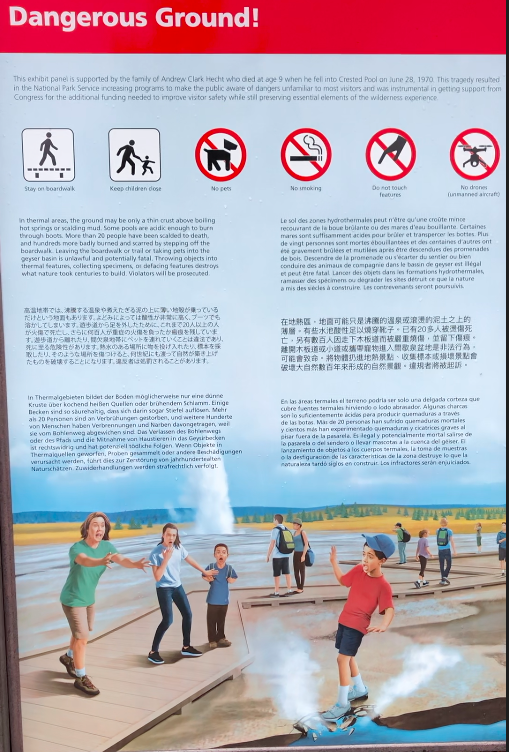
Even though I noted the warning signs, I do not remember their words as vividly as the sounds of the place, so now to recall, I scroll back through photos of the place and read again the dire warnings:
“Dangerous Ground!” the sign screams in the title of white sans serif letters against a red banner. Then comes lots of little print in serif fonts and six different languages, two of which require entirely different alphabets. The fine print is skippable. Not as easy to skip the icons: Two things are advised 1. Stay on boardwalks. 2. Keep children close. Then the things prohibited: No pets, No smoking, Do not touch features, and No drones.
What’s not easy to skip is the illustration: A smallish geyser erupts in the background. In the foreground, a child totters on the brink of steaming pool. He wears a blue baseball cap, red t-shirt, and mid-shin white socks. He has unwisely left the boardwalk. The ground beneath his white sneakers crumbles. His parents and younger brother, all of whom appear to follow the sign’s #1 rule, gasp then grasp in alarm. Based on the angle of the boy’s totter, we might as well assume he’s destined for a dip in the boiling pool.
In the background of this dramatic illustration are seven people pacing the boardwalk path. All show a fine disregard for imminent loss of life. They carry backpacks. They point out geothermal features. They pose for pictures. This is what I remember of the place in addition to the sounds. I remember the sign. I remember laughing at the absurdity of the illustration, especially those white socks hiked high out of white sneakers. I remember—then feel forever afterward shamed by finding humor in tragedy—reading the fine print:
“This exhibit panel is supported by the family of Andrew Clark Hecht who died at age 9 when he fell into Crested Pool on June 28, 1970. This tragedy resulted in the National Park Service increasing programs to make the public aware of dangers unfamiliar to most visitors and was instrumental in getting support from Congress for the additional funding needed to improve visitor safety while still preserving essential elements of the wilderness experience.”
Have I mentioned the name of the place? I have not. It’s Yellowstone National Park.
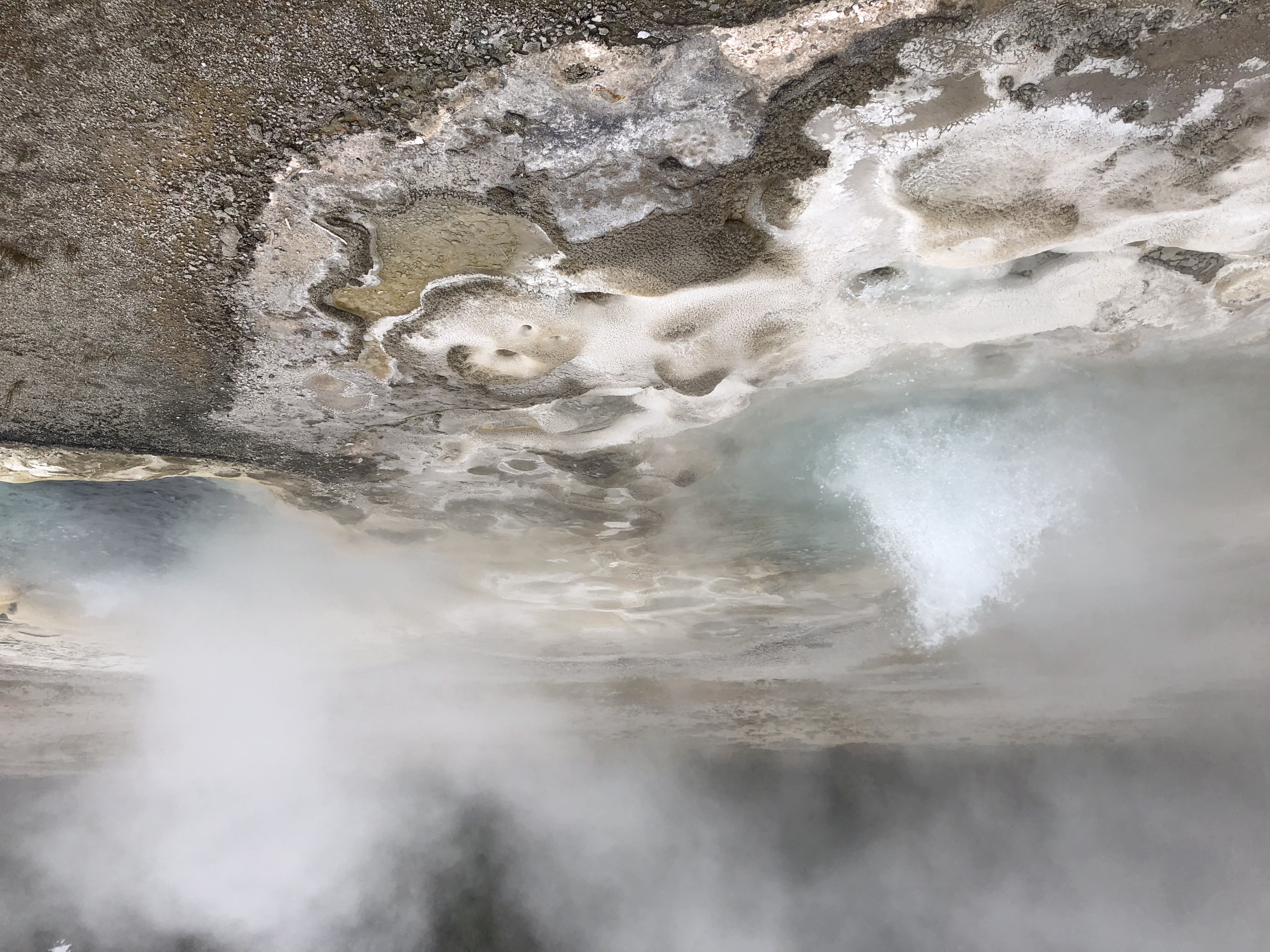
We’ve all visited Yellowstone. Maybe not in person, but we know documentaries or pictures of this iconic National Park. We’ve seen Old Faithful, certainly. But we haven’t seen Crested Pool or the paths that navigate the “essential elements of the wilderness experience.” It was the unpredictable geysers and deceptive pools of Yellowstone that convinced me I needed to read the fine print very, very carefully. I related to the mother in a warning sign’s illustration—my hand hovered over my mouth gasping in horror. My other hand reached to grab a daughter’s backpack strap. I had brought two children with me to visit the Park’s essential elements, nay, dangers. One daughter was age 13, one age 9. Andrew Clark Hecht’s age, a detail not lost on me once I absorbed the sign’s finest print.
Yellowstone alerted me to the danger of assuming I knew a place. I was prepared for the highlight to be Old Faithful towering far above my head and reappearing a dependable hour later. Neat. Also, ho-hum. I thought Yellowstone would be grassy plains and mountains and lodgepole pines and bison. Neat. Also, ho-hum. I did not expect suplpherous belches making me pinch my nose or pools of water so turquoise I wanted to encapsulate the color in a ring on my finger or the demonic fumarole tea kettle whistling alongside a road leading to more spectacular features. Not one bit ho-hum.
Scrolling through pictures from the trip, I remember visiting the aptly named “Surprise Pool.” Just inches from the promised safety of a geyser basin’s boardwalk trail, Surprise Pool bubbled away with a merry temperature that could scald feathers off a chicken. The water was a blue that Crayola names “Robin’s Egg Blue” in a box of 56 colored crayons. Steam danced right off the edge of the pool’s stage. Surprise Pool bubbled in perpetuity. It’s bubbling away right now. I think of its pips and pops and blips and dibbles as I wandered past gripping children’s hands.
What I miss about the place is the sound of Gerry’s voice, a companionable, gruff, manly tour guide’s voice, encouraging us along the road. We called our roadtrip audioguide Gerry, with a G. Why? I don’t remember. He never introduced himself, so Jerry or Gerry, it wouldn’t matter to him and was almost certainly not the man’s name anyway, but something in our group’s collective brains felt good and settled about calling the voice Gerry with a G, so Gerry it was who told us when to turn right or look left. Gerry informed us of all there was interesting to know as we wound our way through the place. Gerry narrated us from one paint pot to a geyser basin and back again. I think of the place and a minivan and granola bar wrappers and beef jerky and trail mix and water bottles and phone charger cords and maps and coats and trail running shoes and umbrellas and Gerry. I think of our friend’s RV following our minivan. The RV carried roadtrip extravagancies of a flushing toilet and a full-size bed and an oven that baked chocolate chip cookies even while proceeding down the highway at 70 miles per hour. Gerry traveled in the RV as well. I miss Gerry’s voice.
Yellowstone’s warning signs, if you read the small print or listen carefully to Gerry, informs: “In thermal areas, the ground may be only a thin crust above boiling hot springs or scalding mud. Some pools are acidic enough to burn through boots. More than 20 people have been scalded to death, and hundreds more badly burned and scarred by stepping off the boardwalk.” I take the sign at its word. We didn’t dream of stepping a foot off the boardwalks that thread between pools and fissures and fumaroles and geysers and mud pots and hot springs. So explain to me the buffalo poop.
All over the thin-crusted plate of earth surrounding deadly “essential elements of the wilderness experience,” we saw piles of buffalo dung and cloven-hoofed footprints. How did those hulking beasts tiptoe between cauldrons of death and live to poop another day? Gerry told us the more brilliant aquamarine the water, the hotter the temperature. Why do we not spy boiled bison skeletons—jumbled white sticks and knobby joints—at the bottom of sapphire pools?
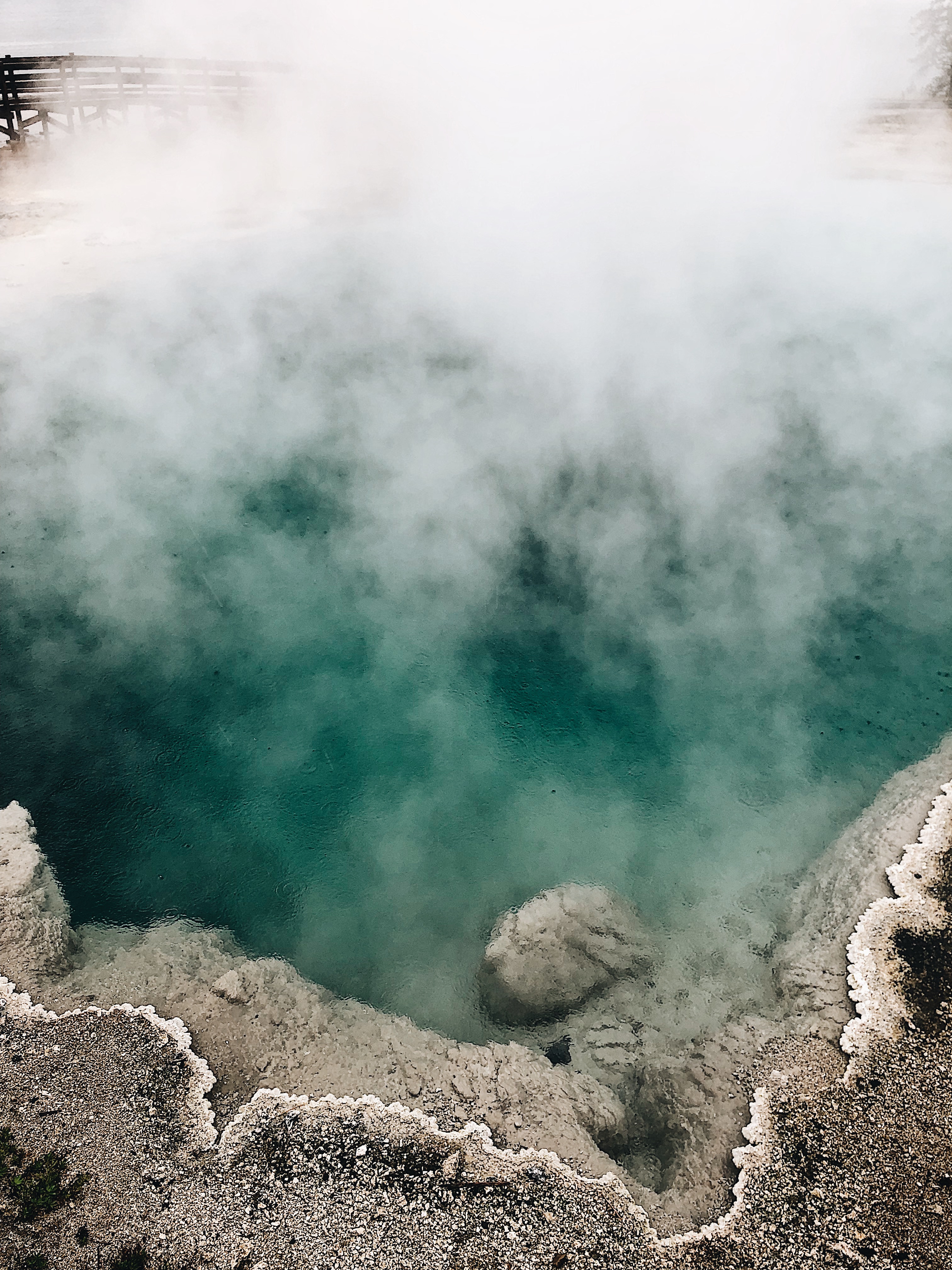
Today I’m immersed in a grey Pittsburgh December day. The temperature is not hot and also not cold, and I think of Surprise Pool and wonder what it might sound like right this minute. I think of the boardwalks inaccessible thanks to Yellowstone’s snow accumulation. Without a human audience, Surprise Pool must still be bipping and bopping away, turning every snowflake into a steam fairy that trips off elsewhere. Surprise Pool’s merry music delights only a bison plodding past, a beast finding a path along the earth’s crust so thin it crumbles under the weight of a nine-year-old human.
One of the first white men to stumble into the Yellowstone region and record his experience was John Colter in the winter of 1807-1808. John peeled off from the Lewis and Clark expedition he’d been with until that point and headed into a wilderness he could only later explain in supernatural terms, and not the kind of supernatural that attracts eternal visitors of an angelic sort. Colter reported seeing “hidden fires, smoking pits, noxious steams, and smell of brimstone.” I imagine Colter’s terrors writhing up from the underworld and wreathing his head as he carved paths through snow (no boardwalks would be erected then or in Colter’s near future) and dodged steaming piles of bison poop. John Colter returned to civilization, reported his experience, and got labeled either liar, insane, or demon-possessed. Colter journaled, “Many thought I had grossly exaggerated my observations of the phenomenon in this region.”
Gerry taught me this history as we drove through Yellowstone. I longed to see herds of buffalo in the wide open expanses, especially where the Madison River winds through the park near West Yellowstone. Gerry was particularly encouraging about our wildlife viewing chances in that area. To kill time as we drove along, Gerry narrated stories of early park explorers. I miss the sound of Gerry’s jokes, which he agreeably laughed at himself, being an audioguide and therefore not privy to sharing the chuckles in our minivan. On my balmy winter Pittsburgh day, I search historic records to see what others before me found in Yellowstone. Were they satisfied with bison sightings? Did they struggle to convey the multi-sensory experience of the park?
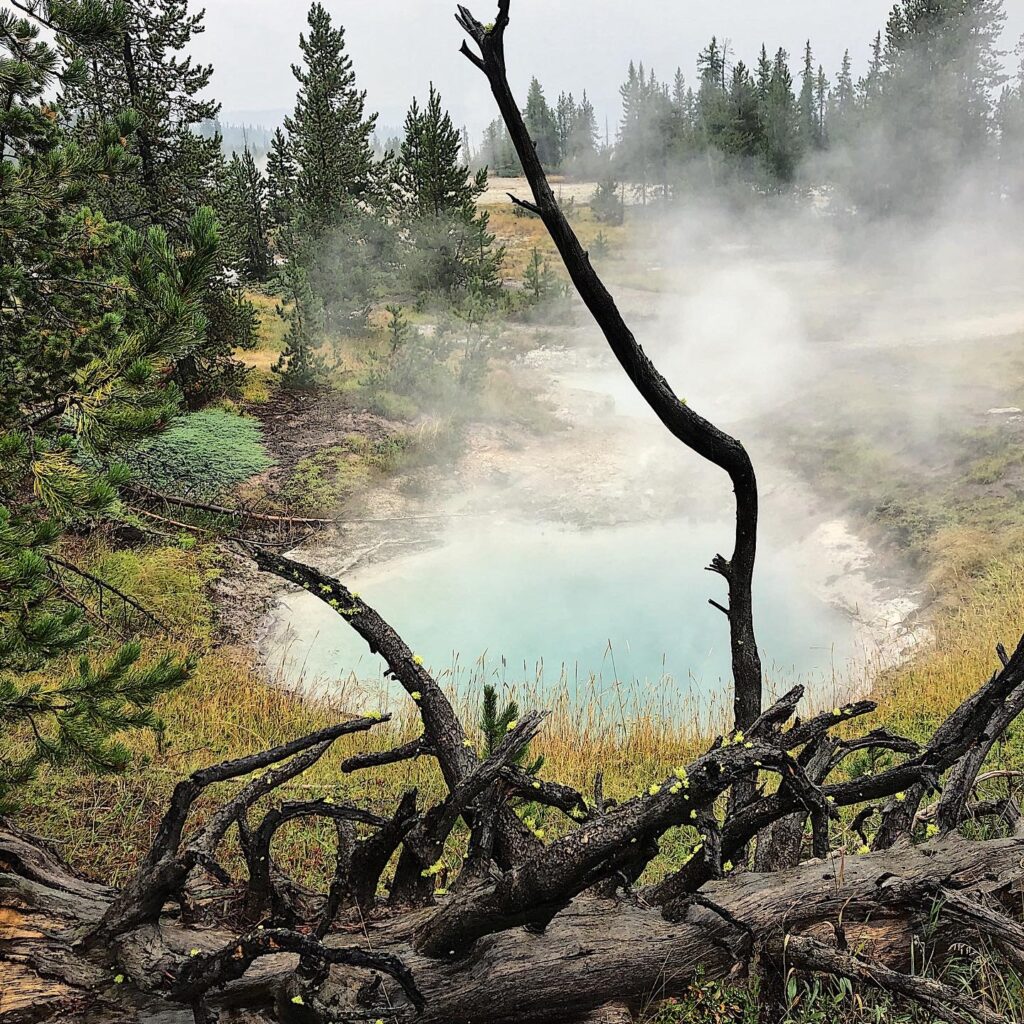
I find a kindred spirit in Captain Benjamin L. E. Bonneville who journaled his Yellowstone experience from 1832 to 1835. The Captain called the place a “volcanic tract with gloomy terrors, hidden fires, smoking pits, noxious streams and the all-pervading ‘smell of brimstone’.”
One notable account of Yellowstone came from a fur trapper named Warren A. Ferris in 1834. He shared, “When I arose in the morning (May 20, 1834), clouds of vapor seemed like a dense fog to overhang the springs, from which frequent…explosions of different loudness constantly assailed our ears. From the surface of a rocky plain or table burst forth columns of water, of various dimensions, projected high in the air, accompanied by loud explosions and sulphrorous vapors, which were highly disagreeable to the smell. I ventured near enough to put my hand into the water of the basin, but withdrew it instantly for the heat of the water in this immense cauldron was altogether too great for my comfort; and the agitation of the water, the disagreeable [vapor] constantly exuding, and the hollow unearthly rumbling under the rock on which I stood so ill-accorded with my notions of personal safety, that I retreated back [quickly] to a respectful distance.”
On the foggy, sulfurous morning of May 20, 1834, Warren heard what I later heard on August 19, 2021. Warren needed no National Park sign to respect the dangers of the ground beneath his feet. It all “so ill accorded with [his] notions of personal safety,” that he ran away. Good man. But Yellowstone tempted others to return. Men and women have been drawn since as inexplicably as trespassing nine-year-olds to tip toe through terrors reeking of brimstone and chattering like demonic tea parties.
This year in 2021, Yellowstone National Park had 4,472,982 recreation visits, up 32% from the same period in 2020. 2020 can’t be blamed for being a pandemic year that had such effective warning signs most people stayed home to wipe groceries with sanitizing wipes rather than sightsee a hellish crust of earth in Wyoming and Montana. Yet in 2021, nearly four and a half million people finished with their pandemic cautions and came to experience the essential elements in Yellowstone. 4.5 million eyes saw the steaming pools, ears heard the splatting mud pots, noses smelled the sulfer.
Much rarer numbers were seen among the Park’s bison herds. Gerry promised me we’d spy this most proliferate resident of Yellowstone Park, but what power does an audioguide really have to make wild animals appear for a photo shoot? I loved Gerry, I really did, but in the end he proved fallible. We saw very few buffalo. We eventually found one by the side of the road, blinking magic-eight-eyeballs and refusing to focus on the frenzied humans waving from behind the safety of a minivan window pane. The buffalo crossed the road. That noteworthy event caused a traffic jam pile-up so long we waited 45 minutes while entertained by Gerry’s tutelage.
The bison were uninterested in the drama of human wildlife. There were, after all, 4,472,982 of us. We were more common than the fleas springing from the carpets of fur buffalo called coats. With a massive shrug of a shoulder, the bison beside our car (captured forever as a forehead, horn, eyeball, and ear filling the frame of my camera) shook off all notice of us and lumbered toward a less human-infested stretch of Yellowstone.
My first proper introduction to Yellowstone’s essential elements came when we first stopped in the Park at the Western Geyser Basin. It was a gentle, rainy morning. I deposited my children in our friend’s trailing RV for fresh chocolate chip cookies. I predicted warm, crusty, sugary treats would be preferable to walking a boardwalk in drizzle. I could not have been more misguided in that decision. No mouthful of chocolate chip goo could beat a mouthful of Yellowstone’s sulpherous fog. With raincoat hoods up and pants soaking drips, my husband and I squeaked along our first Yellowstone boardwalk. Under the boards, the hot crust of earth sizzled and spit back at the rain. We stopped at the banks of Yellowstone Lake, an expanse of grey water that disappeared into a horizon of fog. A grey cone of volcanic earth bubbled between us and the lake’s edge. A sign designated the geyser as Fishing Cone Hot Spring.
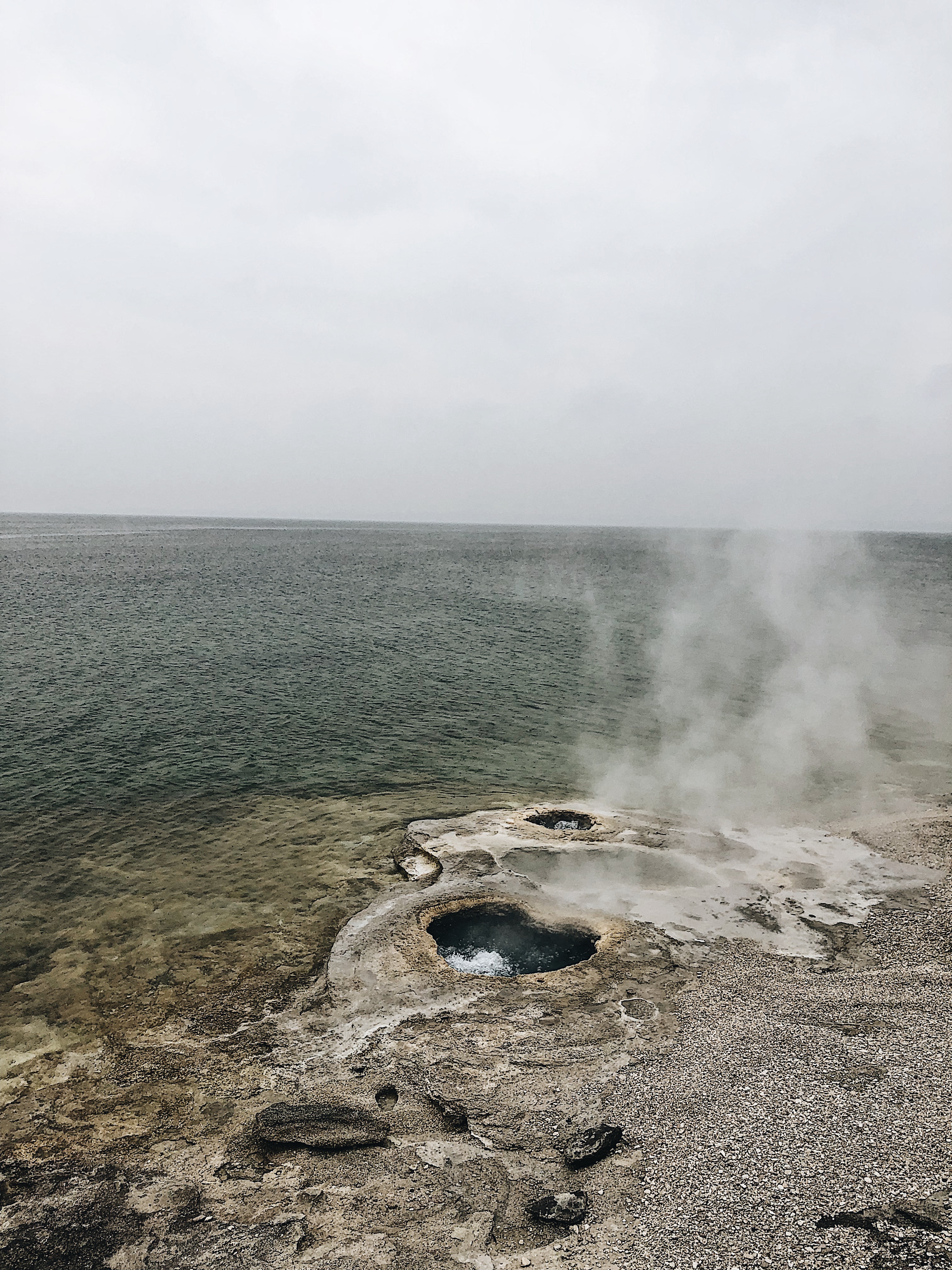
Gerry had prepped me with the story of Fishing Cone on our drivein. Early explorers found ample fish in Yellowstone Lake, and one fortunate fisherman hooked a trout and swung it back toward the shore. But as he did so, the fish accidentally got off the hook and fell into the spring now called Fishing Cone. The fish darted about cheerily for all of a minute or two before it floated to the top, belly-up, good and dead and boiled. Lunch served. Many people put Fishing Cone to the test (haul the fish from the lake, dip it still hooked on the line into the cone, cook, and eat), but in recent years, signs have been erected. It’s easy to guess what they warn—Do not fish in Fishing Cone. My husband and I stood on a soggy boardwalk at a very respectful distance from nature’s empty pot of boiling water.
What I miss about the place are the sounds of Yellowstone National Park. No scroll through my photo albums nor page flip of a guidebook equals what it’s like to stand on Yellowstone’s ground and hear burbles, whuffles, farts, pops, pips, plops, and belches. As all early explorers experienced, explaining the truths of Yellowstone makes an insane person out of its describer. Yellowstone Park must be experienced. Otherwise, it’s the hellish, fantastical dreams of a crazy person who catches fish in crystal cold water and then scalds it alive in a neighboring pool. Wait five minutes, sprinkle some salt, and that fish disappears in a mouth of gnashing teeth. Yellowstone marvels humans. What do the bison think about the fish trick? Neat. But also, ho-hum. They know all the park’s secret paths. We humans barely dare set foot on the surface.
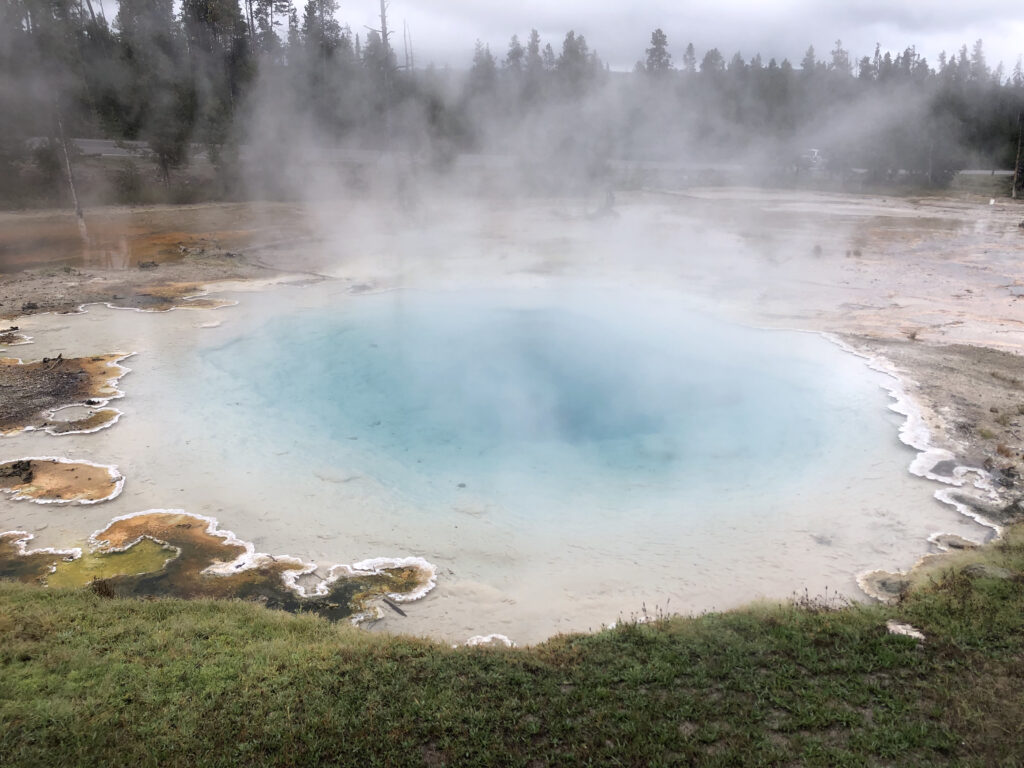
With 2.2 million acres, Yellowstone’s larger than the states of Rhode Island and Delaware combined. Math tells me I might have to share a single acre with one other person or the occasional bison. Park signage may dissuade visitors from a first-hand experience of the park’s marvels, and our own assumptions may trick us to think we’ve second-handedly experienced the pastoral beauty of the Park (with gratitude to Remington, Russell, Catlin, Bierstadt, Moran, and L’Amour). What I miss most about the place are the sounds. It’s one place that really must be heard to be believed.


Great job capturing this place and our memories. I love that you used “a fine disregard.”
Your deep description was so vivid and alive that I am duly subdued by its majesty so say “I cant even imagine!’